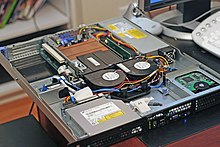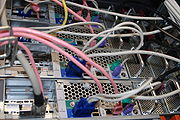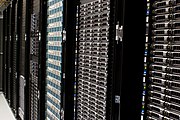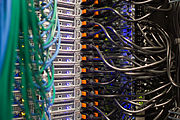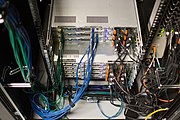Server
A server is a set of computers capable of handling client requests and returning a response accordingly. Servers can be run on any type of computer, even dedicated computers that are individually referred to as "the server." In most cases, the same computer can provide multiple services and have several servers running. The advantage of setting up a server on dedicated computers is security. For this reason, most servers are processes designed in such a way that they can run on special-purpose computers.
Servers operate through an architecture called client-server. Servers are running computer programs that serve requests from other programs: clients. Therefore, the server performs other tasks for the benefit of the clients; it offers them the possibility of sharing data, information and hardware and software resources. Clients usually connect to the server through the network, but they can also access it through the computer where it is running. In the context of Internet Protocol (IP) networks, a server is a program that operates as a listener for a socket.
Commonly, servers provide essential services within a network, either for private users within an organization or company, or for public users over the Internet. The most common types of servers are database server, file server, mail server, print server, web server, game server, and application server.
A large number of systems use the client-server network model, including Web sites and mail services. An alternative model, the peer-to-peer network model, allows all connected computers to act as clients or servers as needed.
Use
The term server is widely used in the field of information technology. Despite the wide availability of products labeled as server products (such as versions of hardware, software, and OS designed for servers), in theory, any computational process that shares a resource with one or more client processes is a server. Let's take file sharing as an example. While the existence of files within a computer does not classify it as a server, the mechanism in the operating system that shares these files to clients does qualify as a server.
Similarly, consider a web server application (such as the cross-platform "Apache" server). This web server can be run on any type of computer that meets the minimum requirements. For example, while a laptop (in English, laptop) or personal computer are not usually considered as servers, in certain cases (such as the above) they can fulfill the role of one and therefore be called servers. In this case, it is the role of the computer that places it in the server category.
In the hardware sense, the word server typically labels computer models designed to host a set of applications that are in high demand within a network. In this client-server configuration, one or more computers (either a computer or a computer program) share information with each other in such a way that one acts as a host (in English, host) of the others.
Almost any personal computer can act as a server, but a dedicated server will have qualities more suited to a production environment. These qualities include a faster central processing unit (CPU), improved random access memory (RAM) for high performance, and increased storage capacities in the form of multiple hard drives. The servers also have other qualities such as reliability, availability and serviceability (RAS) and fault tolerance, the latter in the form of redundancy in terms of the number of sources, in data storage as a redundant group of independent disks (RAID) and multiple network connections.
Servers became commonplace in the early 1990s as businesses began using personal computers to deliver services that were previously hosted on mainframes or microcomputers. Early file servers featured multiple CD stacks, used to host large database applications.[citation needed]
Between 1990 and 2000 the increase in the use of specific hardware marked the advent of self-sufficient server applications. One of these well-known applications is the Google Search Appliance, which combines hardware and software in one out-of-the-box packaging. Similar products were the Cobalt Qube and the RaQ. Simpler examples of such equipment include switches, routers, gateways, and print servers, all of which are easily usable through a plug-and-play configuration.
Modern operating systems like Microsoft Windows or Linux distributions appear to have been designed on a client-server architecture. These operating systems abstract from hardware, allowing a wide variety of software to work with computer components. In a way, the operating system can be seen as a server from hardware to software because, except in low-level programming languages, software must interact with hardware through an API.
These operating systems are capable of running programs in the background which are called services or daemons. These programs, including the previously mentioned Apache HTTP Server, can remain in a dormant state until needed for use. Since any software that provides services can be called a server, modern personal computers can be seen as forests of client and server applications operating in parallel.
The Internet itself is a forest of servers and clients. Just requesting a web page from a server a few miles away leads to satisfying a network protocol stack that includes several examples of server hardware and software usage. The simplest of these are routers, modems, DNS servers, as well as others without whose interaction we could not access the web.
The advent of cloud computing allows storage servers, as well as sharing resources with a common pool; it also allows servers to maintain a higher degree of fault tolerance.
Hardware requirements
The hardware requirements for servers vary depending on the type of server application. CPU speed is not as critical for a server as it would be for a desktop machine. The duty of servers to provide services within a network to a large number of users imposes different requirements, such as high-speed connections and high performance for all I/O devices. Since servers are generally accessed over the network, they can function without the need for a monitor or other input devices. Those processes that are not required for server functions are not used. Many servers do not have a graphical user interface (GUI) as this functionality consumes resources that can be used by other processes. Likewise the audio and USB interfaces can also be omitted.
Servers run for long periods of time without interruption and their availability must be high most of the time, making hardware reliability and durability extremely important. Although servers can be assembled from common computer parts, those servers that perform critical tasks within a company's infrastructure are ideally highly fault tolerant and use specialized failure-rate hardware to maximize uptime, as a A single short-term failure can cost more than buying the parts and installing the entire system. Servers can include higher capacity and speed disks, water cooling systems, larger heat sinks to reduce heat, uninterruptible power supplies that guarantee server operation in the event of a power failure. These components offer higher performance and reliability corresponding to a higher price. Hardware redundancy—installing more than one instance of a module such as the power supply or hard drive arranged so that if one fails the other is automatically available—is widely used. ECC memory devices are used that detect and correct errors; other non-ECC memory types can lead to data corruption.
To increase reliability most servers use memory for error detection and correction, redundant disks, redundant power supplies, and more. It is common for these components to be hot-swappable, allowing technicians to replace faulty parts on a server without having to power it down. Servers usually have better heatsinks to prevent overheating. Since in most cases the servers are managed by qualified system administrators, the operating system they have is more focused on stability and performance than on appearing welcoming and easy to use, with Linux being the one with the highest percentage of use. take.[citation needed]
Since most servers are noisy and need stable power supply, good Internet access, and better security, it is common to store them in server centers. Since the servers are grouped, energy consumption is always reduced, since the extra energy used produces an increase in the temperature in the room, which causes the acceptable temperature limits to be exceeded; For this reason, most of the rooms for servers have air conditioning equipment. The top of most servers tends to be flat and wide (usually measured in "rack units"), suited for storing multiple devices together on a server rack. Unlike ordinary computers, servers can be remotely configured, turned on, turned off, or rebooted using remote management, usually based on IPMI.
There are many servers that take time to boot the hardware and initialize the operating system. It is common for servers to perform extensive memory tests before initializing in addition to initializing and verifying remote management services. Hard drive controllers boot devices sequentially, rather than all at once, so as not to overload the power supply with bootloading, and then initiate the RAID system check to test that redundant operations are working properly. It is common for a server to take several minutes to initialize but may not need to be rebooted for months or years.
|
Operating systems
Server-oriented operating systems have certain qualities that make them more suitable for a server environment, such as
- Optional GUI or not available
- The ability to reconfigure and update hardware and software without the need to restart
- Advanced copying facilities to allow regular online copies of critical data
- Transparent transfer of data between different volumes or devices
- Advanced and flexible qualities for working with the network
- Automation features such as UNIX daemons and Windows services
- Strong system security with advanced protection to users, data, resources and memory
In many cases, server-oriented operating systems can interact with hardware sensors to detect conditions such as overheating, disk or processor failure, and alert your operator accordingly or take rectifying measures yourself.
Because servers must provide a limited set of services to multiple users while a personal computer must support a wide variety of functionality required by its user, the operating system requirements for a server are different from those of a desktop computer. desk. Although it is possible for one operating system to make a computer provide services and respond quickly to a user's requests, the use of different operating systems on servers and personal computers is common. Some operating systems come in their personal (desktop) and server (server) versions with similar user interfaces.
The server operating systems of Windows and Mac OS X are used on a minority of servers, as other paid mainframe operating systems such as z/OS also exist. The predominant server operating systems are those that follow open source UNIX software distributions such as those based on Linux and FreeBSD. The rise of microprocessor-based servers was facilitated by the development of UNIX to run on the x86 microprocessor architecture.. The Microsoft Windows family of operating systems can also run on x86 hardware, and since Windows NT, it is available for versions suitable for server use.
While the role of server and personal computer operating systems remains different, improvements in both hardware and operating system reliability have blurred the distinction between these two classes. Today many operating systems for personal computers and for servers share the same code bases, differing mostly in their configuration. The shift towards web applications and middleware platforms have also fueled the demand for specialized application servers.[citation needed]
Server Types
In the following list are some common types of servers:
- File server: is the one that stores several types of files and distributes them to other customers on the network.
- Printer Server: Controls one or more printers and accepts printing works from other network customers, queuing the printing works (although it can also change the priority of the different prints), and performing most or all other functions that on a work site would be performed to achieve a printing task if the printer was directly connected to the printer port of the work site.
- Mail server: store, send, receive, route and perform other operations related to e-mail for network customers.
- Fax server: store, send, receive, route and perform other functions necessary for the proper transmission, reception and distribution of faxes.
- Telephone server: performs functions related to telephony, as is the answering machine, performing the functions of an interactive system for the response of the voice, storing the voice messages, directing the calls and also controlling the network or the Internet, e.g., excessive voice entry on IP (VoIP), etc.
- Proxy server: performs a certain type of functions on behalf of other customers on the network to increase the operation of certain operations (e.g., prefetching and depositing documents or other data that are frequently requested), also provides security services, that is, includes a firewall. It allows to manage internet access in a computer network allowing or denying access to different websites.
- Remote Access Server (RAS): controls the modem lines of monitors or other network communication channels so that requests connect with the network of a remote position, responds incoming phone calls or recognizes the request of the network and performs the necessary authentication and other procedures necessary to register a user on the network.
- Use server: performs the logical part of the computer or business of a customer use, accepting the instructions for the operation of a work site and serving the results in turn to the work site, while the work site performs the operating interface or portion of the process GUI (i.e., the logic of the presentation) that is required to work properly.
- Web server: Stores HTML documents, images, text files, writings, and other data-composed Web material (known collectively as content), and distributes this content to customers who ask it on the network.
- Database server: provides database services to other programs or other computers, as defined by the customer-server model. You can also refer to those computers (servers) dedicated to implementing those programs, providing the service.
- Reserve server: has the network backup software installed and has large amounts of network storage on hard drives or other forms of storage (five, etc.) available for use in order to ensure that the loss of a main server does not affect the network. This technique is also called clustering.
- Security Server: It has specialized software to stop malicious intrusions, usually have anti-virus, anti-spyware, anti-malware, in addition to having redundant firewalls of various levels and/or layers to prevent attacks, security servers vary depending on their use and importance.
However, according to the role they assume within a network, they are divided into:
- Dedicated server: are those who dedicate their full power to managing the resources of the network, that is, to answering the processing requests of customers.
- Non-dedicated server: are those who do not dedicate all their power to customers, but can also play the role of workstations when processing requests from a local user.
- Videogame server: is a local or remote server used by video game clients to play multiplayer video games. Most of the video games played over the Internet work through a connection to a video game server.
Power consumption
In 2010, data centers (servers, cooling, and other electrical infrastructure) consumed 1.1 to 1.5% of electrical energy in the world and 1.7 to 2.2% in the United States.
Specifically, this consumption is less than that of 6 billion mobile phones in the world when they go to recharge their batteries. Even this consumption may seem negligible, based on domestic heating, cooling and water heating consumption rates, which are in the double digits. Finally, the Smart2020 report estimates that ICT (Information and Communications Technology) saves more than 5 times its carbon footprint than the rest of the economy by increasing efficiency.
Size classes
Size classes include[citation needed]:
- Rack servers
- Tower server
- Miniature servers
- Mini servers rack
- Server blade
- Mobile servers
- Ultra-dense servers
- Super servers
Contenido relacionado
Electronics
C++
Compiler
